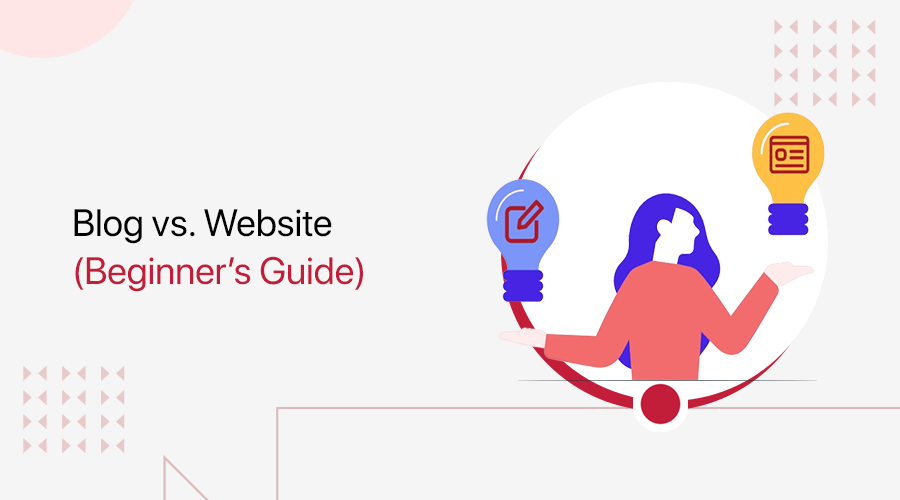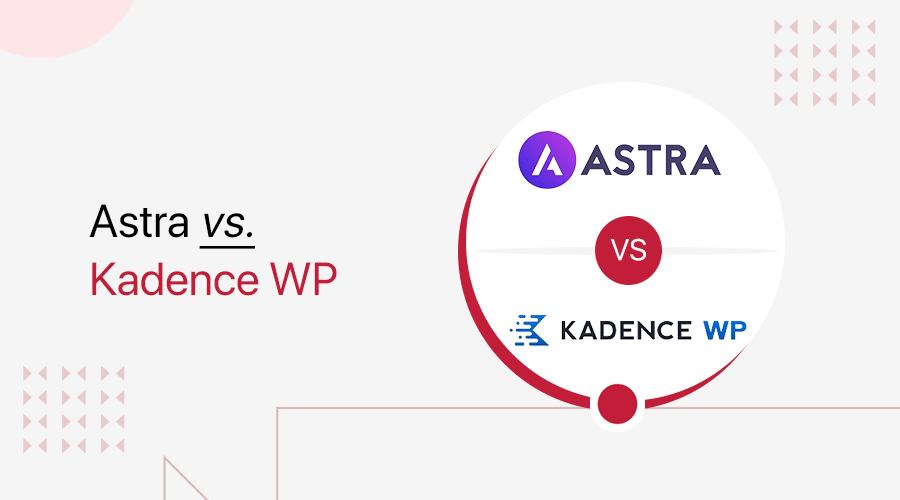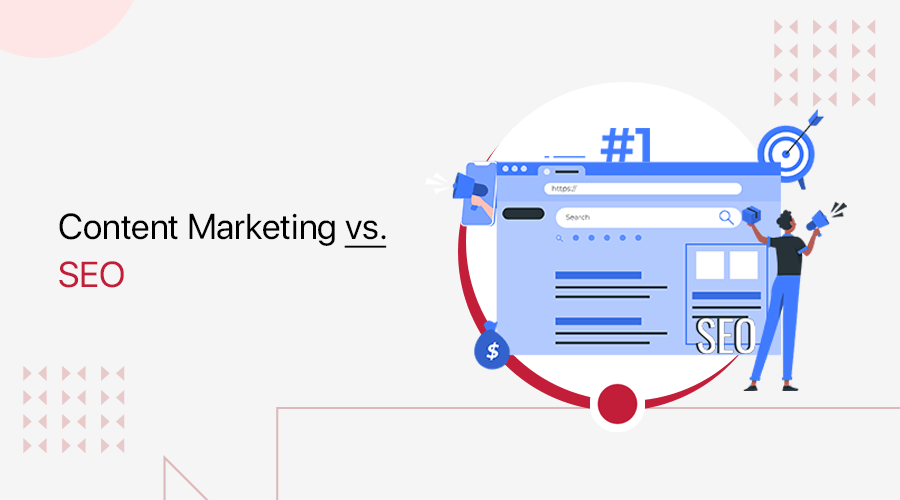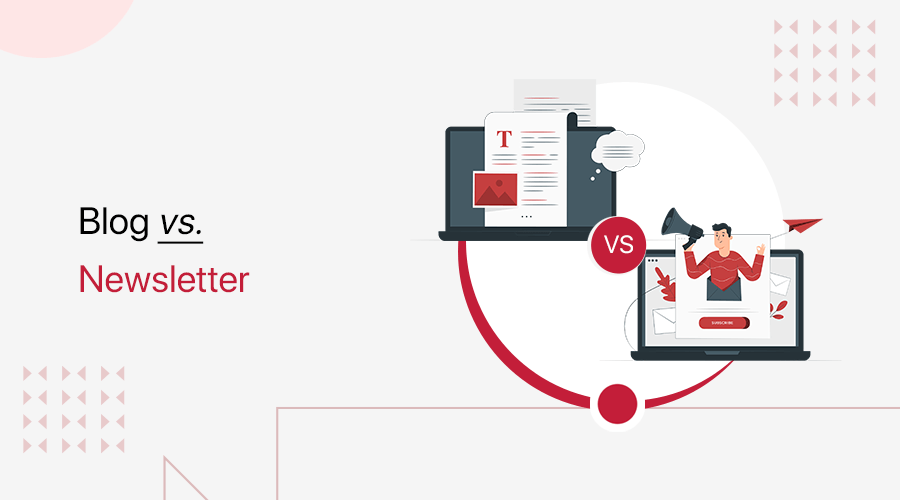
Wondering which is a better strategy between blog vs newsletter? If yes, then this article is just for you!
Blogs and newsletters are 2 popular forms of content marketing that can help you attract, educate, and convert your audience. However, they have different purposes, formats, reach, and importance.
But what kind of content should you focus on? Should you start a blog or send a newsletter? Or maybe both?
In this article, we’ll explore both blogs and newsletters and compare them closely. So, you can decide which one is the best strategy for your business goals.
So, let’s dig in!
Table of Contents
A) Quick Comparison Table: Blog vs Newsletter
Short of time? Here’s a quick comparison table between the blog vs newsletter on several criteria.
| Criteria | Blog | Newsletter |
| Frequency | Updated more frequently, no set schedule. | Sent on a regular schedule, weekly or monthly. |
| Length | Varies widely, and can be short or long. | Usually concise and contained in a single email. |
| Purpose | Provides in-depth information on a topic. | Provides useful content and links to stay in the know. |
| Audience | Anyone on the internet can access it. | Only subscribers who have opted in receive. |
| SEO (Search Engine Optimization) | Helps to improve search engine rankings and drive traffic. | Does not directly affect SEO, but can link to blog posts. |
| Engagement | Allows readers to comment and share. | Allows readers to reply and forward. |
| Conversion | Can include calls to action and lead magnets. | Can include offers and promotions to drive sales. |
Now, let’s move forward to take a closer look at the comparison of blog vs newsletter in detail.
B) Understanding Blogs
A blog is a type of website that contains regularly updated posts on a specific topic or niche. It’s usually written by individuals, businesses, organizations, or groups of people.
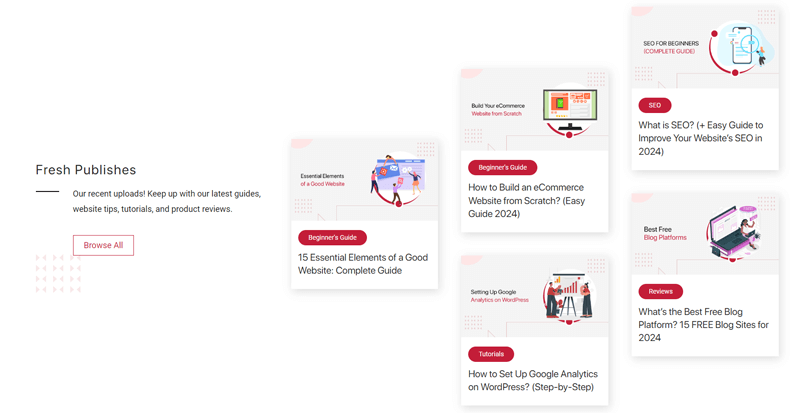
It can have different formats, styles, and tones, depending on the purpose and audience of the blog.
Purpose of Blogs
Blogs can serve various purposes, depending on the goals and preferences of the blogger. Some of the common purposes of blogs are:
1) Sharing Expertise and Insights
With blogs, you can share your knowledge, skills, and experience with the readers, and provide valuable information and advice on a topic. As a result, you can establish authority and credibility in your niche, and also build trust with the audience.
2) Sense of Community
Blogs help to create a sense of community and engagement with the readers. As you allow them to comment, share, and interact with the blog content. This can help you foster loyalty and retention among your audience, and increase your social proof and influence.
3) Increasing Website Traffic and SEO
You can increase your website traffic and improve SEO ranking, by providing fresh and relevant blog content for the target keywords. This attracts more organic and qualified visitors to your website. Further, increasing visibility and exposure online.
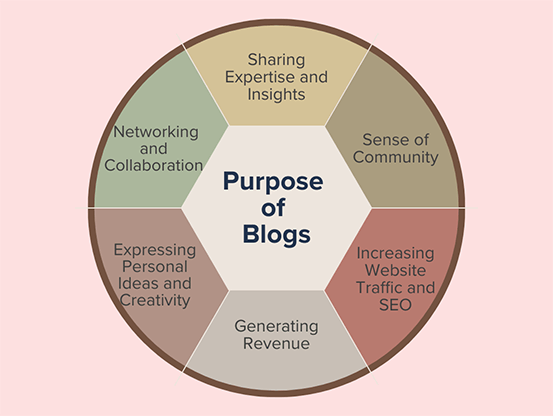
4) Generating Revenue
Blogs are one of the effective ways to generate revenue from various sources. Such as advertising, affiliate marketing, sponsored posts, product reviews, donations, subscriptions, and selling your products or services.
This can help you monetize your passion and expertise, and create a passive income stream.
5) Expressing Personal Ideas and Creativity
As a blogger, blogs are one of the perfect ways to express your ideas, opinions, and creativity, and showcase your unique voice and style. This can help you satisfy your interests and passions, and connect with like-minded people.
Browse our article on types of blogs to get more insight on it.
6) Opportunities for Networking and Collaboration
Blogs can help you create opportunities for networking and collaboration with other bloggers, influencers, experts, and brands in the respective niche. Further, helping you expand your network and reach, and create mutually beneficial partnerships and projects.
Drawbacks
Blogs also have some drawbacks, depending on the challenges and limitations of the blogger. Some of the common drawbacks of blogs are:
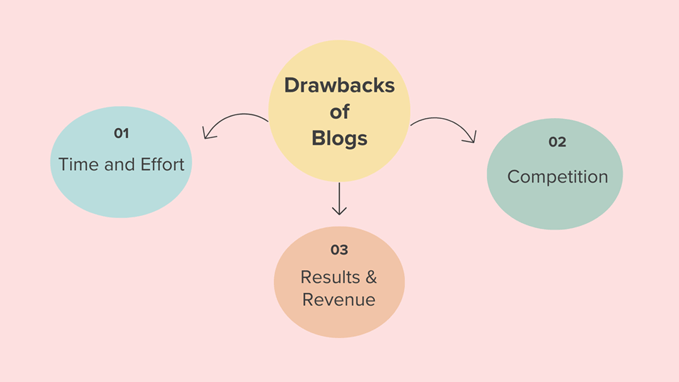
1) Time and Effort:
Blogs require a lot of time and effort to create, maintain, and update. This means you need to research, write, edit, and publish quality content regularly. As well as manage your website, social media, and more. This can be challenging and stressful at times.
2) Competition:
Blogs face a lot of competition and saturation in the online space, as there are millions of blogs on the internet covering various topics and niches. So, as a blogger, you need to stand out from the crowd and differentiate yourself from your competitors.
3) Results and Revenue:
Blogs do not guarantee immediate or consistent results and revenue. So, you need to be patient and persistent.
And invest in your blog for a long time, before you can see any significant outcomes and income from your blog. This can be frustrating and discouraging, especially if you’re a bit ambitious or impatient.
Check our article on how to start a WordPress blog to start your blogging journey right away.
Now, let’s move forward to understand the newsletter.
C) Understanding Newsletter
A newsletter is a digital form of communication that is distributed to subscribers who have requested to receive it via email. It’s used by both individuals and businesses.
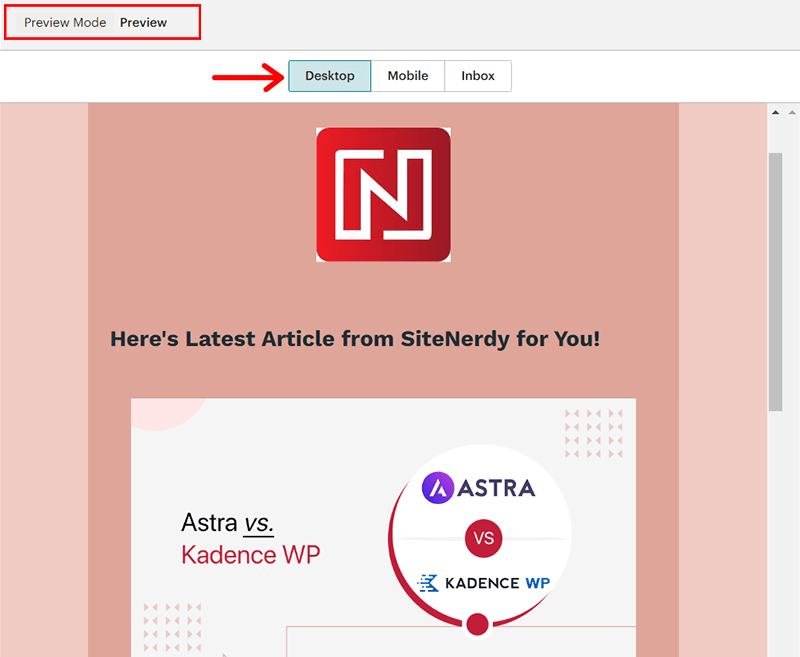
Newsletters are a great tool for staying connected with customers, followers, or clients. You can share useful content and links to stay in the know, promote sales, and drive traffic to your website.
Purpose of Newsletters
Newsletters can serve various purposes, depending on the goals and preferences of the sender. Some of the common purposes of newsletters are:
1) Loyal Audience
Newsletters can help you create a loyal audience that is interested in your niche and your brand. You can boost retention and referral rates by developing a connection with your subscribers by offering insightful and timely content.
2) Directing Traffic
In a newsletter, you can include compelling calls to action and enticing headlines. This encourages your subscribers to click through and explore more of your content. As a result, you can direct traffic to your website or other online platforms, such as your blog, social media, or podcast.
3) Marketing Products or Services
Newsletters can help you market your products or services to your potential and existing customers. You can showcase your offers, features, benefits, testimonials, and case studies. Ultimately, persuading your subscribers to make a purchase or take another desired action.
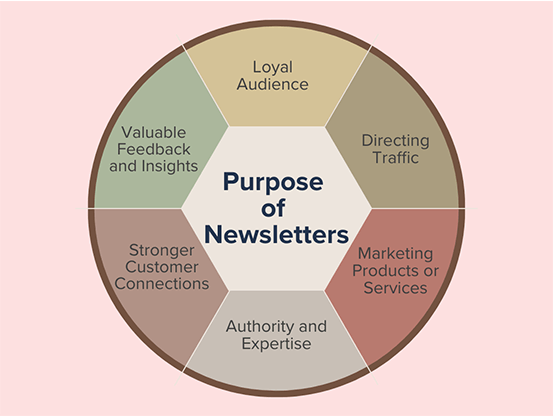
4) Authority and Expertise
You can establish your authority and expertise in your field or industry via newsletters. For instance, you can share your insights, tips, and best practices showing your knowledge and credibility. This helps to position yourself as a thought leader or a trusted source.
5) Stronger Customer Connections
Newsletters can help you create stronger customer connections and relationships. As you’re talking directly to your subscribers and asking for their thoughts in newsletters makes them feel connected. Further, building a strong community and loyalty.
6) Valuable Feedback and Insights
Newsletters can help you get valuable feedback and insights from your subscribers. You can ask them questions, conduct surveys, or invite them to reply to your emails. And use their responses to improve your products, services, or content.
You can also track and measure your newsletter performance. Such as open rates, click rates, and conversions, and use the data to optimize your strategy.
Drawbacks
Newsletters also have some drawbacks, depending on the challenges and limitations of the sender. Some of the common drawbacks of newsletters are:
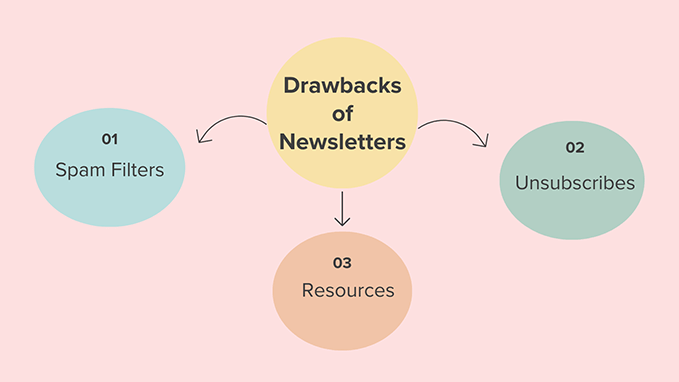
1) Spam Filters:
Newsletters can get caught in spam filters and never reach your subscribers’ inboxes. This can happen if you use spammy words, send too many emails, or have a low sender reputation.
To avoid this, you need to follow the best practices for email deliverability. Such as using a reputable email service provider, verifying your domain, and maintaining a clean email list.
2) Unsubscribes:
Newsletters can cause some of your subscribers to unsubscribe from your list. This can happen if you send irrelevant, boring, or annoying emails, or if you don’t meet your subscribers’ expectations.
To prevent this, you need to segment your list, personalize your emails, and provide value and quality to your subscribers.
3) Resources:
Newsletters require a lot of resources to create, send, and manage. You need to invest time, money, and effort to produce engaging and effective newsletters. As well as to maintain your email list, platform, and strategy. This can be challenging and stressful, especially for small businesses or solo entrepreneurs.
Browse our article on how to create a newsletter to begin your email marketing journey right away.
Now that you’ve understood the blogs and newsletters, let’s understand the key differences.
D) Key Differences: Blog vs Newsletter
As mentioned earlier, both blogs and newsletters are popular forms of content marketing. But, they have key differences that distinguish them from each other.
So, let’s explore them on several grounds.
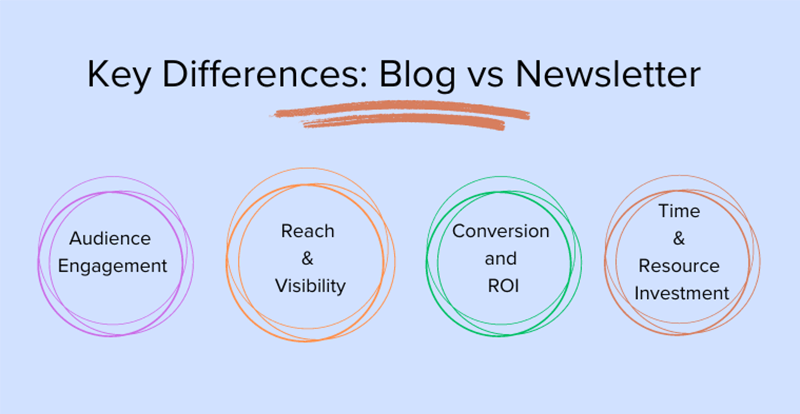
1. Audience Engagement
One of the key factors to consider when choosing between a blog and a newsletter is how you want to engage your audience.
Audience engagement refers to how you interact with your readers, how they respond to your content, and how you measure their feedback.
Here’s a quick table to highlight the difference between a blog vs newsletter in terms of audience engagement.
| Basis | Blogs | Newsletters | Difference |
| Reach | Blogs can reach a wider and more diverse audience. As anyone on the internet can access them. | Newsletters can reach a more specific and loyal audience. As only subscribers who have opted to receive them in their inbox can access it. | Newsletters have a smaller but more target reach, while blogs have a larger but more general reach. |
| Interaction | It can allow readers to interact with the content and the author through comments and social sharing. | It can allow readers to interact with the content and the sender through replies and forwards. | Newsletters have a more direct and personal interaction, while blogs have a more public and social interaction. |
| Feedback | You can get feedback and insights from the readers through analytics, such as page views, bounce rate, and time on the page. | You can get feedback and insights from the subscribers through analytics, such as open rate, click rate, and conversion rate. | Newsletters have more actionable and measurable feedback, while blogs have more qualitative and descriptive feedback. |
2. Reach & Visibility
Another important factor to consider when choosing between a blog and a newsletter is how you want to reach and attract your audience.
Reach and visibility refer to how many people can access and discover your content, and how you can increase your exposure and awareness online.
Here’s a quick table to highlight the difference between a blog vs newsletter in terms of reach and visibility.
| Basis | Blogs | Newsletters | Difference |
| SEO | Blogs can help you improve your SEO and rank higher for your target keywords, by providing fresh and relevant content for your niche. | Newsletters do not directly affect your SEO, as they are not indexed by search engines. Yet, you can link to your blog posts or other web pages in your newsletters, and drive traffic to your website. | Blogs have a direct and positive impact on SEO, while newsletters have an indirect and neutral impact on SEO. |
| Social Media | It can help you increase your social media presence and engagement by allowing your readers to share your content on various social platforms. | It can help you increase your social media reach and visibility, by including social media icons or buttons in your emails. And encouraging your subscribers to follow you or share your content on social media. | Blogs have a more organic and viral potential on social media while newsletters have a more targeted potential on social media. |
| Blogs can help you grow your email list and generate leads, by offering incentives or lead magnets. Such as ebooks, checklists, webinars, etc in exchange for your readers’ email addresses. | Newsletters can help you nurture your email list and convert leads, by providing valuable and relevant information, offers, or updates. And persuading your subscribers to take the desired action. | Blogs have a more passive and inbound role in email marketing, while newsletters have a more active and outbound role in email marketing. |
3. Conversion and ROI (Return on Investment)
The ultimate goal of any content marketing strategy is to convert your audience into customers and generate an ROI for your business.
Conversion and ROI refer to how well your content drives sales and revenue. And how much profit you make compared to the cost of creating and distributing your content.
Here’s a quick table to highlight the difference between a blog vs newsletter in terms of conversion and ROI.
| Basis | Blogs | Newsletters | Difference |
| Offers | Blogs can help you create offers and promotions for your products or services, by including calls to action, landing pages, or lead magnets in your blog posts. | Newsletters can help you deliver offers and promotions for your products or services, by including them directly in your emails or linking to your blog posts or landing pages. | Newsletters have a more direct and immediate impact on conversion, while blogs have a more indirect and long-term impact on conversion. |
| Tracking | It can help you track the conversion and ROI of your content. By using web analytics tools, such as Google Analytics, to measure metrics such as traffic, conversions, and revenue. | It can help you track the conversion and ROI of your content. By using email marketing tools, such as Mailchimp, to measure metrics such as open rate, click rate, and revenue. | Newsletters have a more accurate and reliable tracking of conversion and ROI. While blogs have a more approximate and variable tracking of conversion and ROI. |
| Cost | Blogs can have a high upfront cost of creating and maintaining your website, domain, and hosting. But, a low ongoing cost of producing and updating your content. | Newsletters can have a low upfront cost for setting up your email list and platform. But, a high ongoing cost of sending and managing your emails | Newsletters have a lower initial investment but a higher recurring expense, while blogs have a higher initial investment but a lower recurring expense. |
4. Time & Resource Investment
The final factor is to consider your available time and resources before deciding between a blog or newsletter for content creation and distribution.
Time and resource investment refers to how long it takes you to produce and publish your content. And how much it costs you to do so.
Here’s a quick table to highlight the difference between a blog vs newsletter in terms of time and resource investment.
| Basis | Blogs | Newsletters | Difference |
| Creation | Blogs can take a long time to create, as they require extensive research, writing, editing, and formatting. Plus, you need to follow SEO best practices, such as keyword research, meta tags, etc. | Newsletters can take a short time to create, as they require less research, writing, editing, and formatting. Also, all you need to do is follow email marketing best practices, such as subject lines, preview text, and personalization. | Newsletters have a faster and easier creation process, while blogs have a slower and harder creation process. |
| Maintenance | It can require a lot of maintenance, as they need to be updated regularly with new and relevant content. Also, you need to optimize it for performance, security, and user experience. | It can require less maintenance, as they are sent out on a schedule and do not need to be updated. However, you need to comply with email regulations, such as GDPR. | Newsletters have a lower and simpler maintenance requirement, while blogs have a higher and more complex maintenance requirement. |
| Distribution | Blogs can have a low cost of distribution, as they are hosted on your website or affordable blogging platforms. | Newsletters can have a high cost of distribution, as they are sent through an email service provider. Such as Mailchimp, which may charge you based on the number of subscribers or emails you send. | Newsletters have a higher and more variable cost of distribution, while blogs have a lower and more fixed cost of distribution. |
With that, you’ve now learned the key differences between blogs and newsletters on several grounds. Let’s explore its similarities in the upcoming section.
E) Similarities Between Blog & Newsletter
While blogs and newsletters have many differences, they also share some similarities. That makes them both valuable forms of content marketing.
In this section, we’ll highlight some of the common similarities between blogs and newsletters, and how they can complement each other.
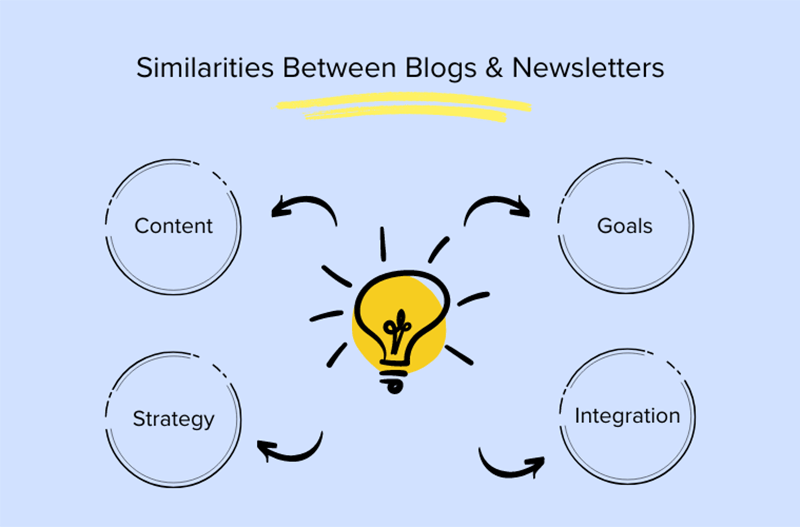
- Content: Both blogs and newsletters share the goal of providing valuable content that fits your brand.
- Goals: Both aim to boost traffic, generate leads, build trust, show authority, engage readers, and drive sales.
- Strategy: Success with both relies on planning your audience, topics, frequency, style, promotion, and analyzing performance.
- Integration: Both complement each other to grow your audience, redirect traffic, cross-promote content, and give a seamless experience.
Now that you understand the differences and similarities between blogs and newsletters, let’s explore the future trends and evolution of both.
F) Future Trends & Evolutions of Blogs and Newsletters
Blogs and newsletters are not static forms of content marketing. They are constantly evolving and adapting to the changing needs and preferences of the audience, the industry, and the technology.
In this section, we’ll explore some of the future trends and evolutions of blogs and newsletters, and how they will impact your content strategy.
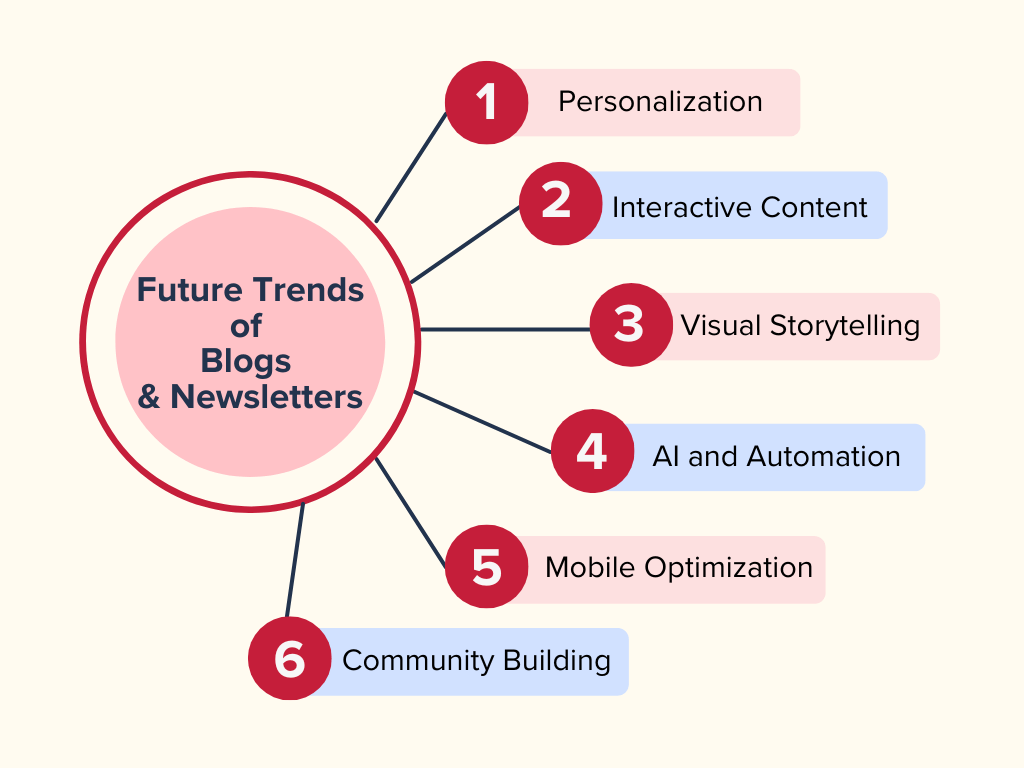
i) Personalization: Both blogs and newsletters are expected to prioritize personalized content delivery. Further, catering to individual reader preferences and interests.
ii) Interactive Content: Expect to see an increase in interactive elements within both blogs and newsletters. such as polls, quizzes, and surveys, enhancing reader engagement.
iii) Visual Storytelling: The incorporation of visual elements like videos, infographics, and interactive graphics will become more prevalent. Further, enriching the storytelling experience.
iv) AI and Automation: The integration of AI (Artificial Intelligence) and automation tools will streamline content creation. Along with distribution, and audience targeting, optimizing efficiency for both platforms.
v) Mobile Optimization: With the rise in mobile usage, blogs, and newsletters will continue to focus on mobile optimization. Ultimately, ensuring seamless accessibility and readability across devices.
vi) Community Building: Both platforms will place a stronger emphasis on community building. Further, fostering meaningful interactions among readers and creators through comments, forums, and live chats.
Whether you’re a blogger or newsletter creator, embracing these future trends is key to staying relevant and succeeding in a changing digital world.
G) Blog vs Newsletter – Which is a Better Strategy?
After comparing and contrasting blogs and newsletters based on various criteria, let’s come back to the main point.
Which one is a better strategy for your content marketing needs?
Well, it depends on several factors, such as your goals, audience, resources, and preferences.
You can choose a blog if you want to:
- Reach a wider and more diverse audience.
- Improve your SEO and rank higher on search engines.
- Establish your authority and expertise in your niche.
- Express your personal ideas and creativity.
- Create evergreen and in-depth content.
Meanwhile, you can choose a newsletter if you want to:
- Reach a more specific and loyal audience.
- Increase your engagement and conversions.
- Market your products or services.
- Create stronger customer connections.
- Create concise and timely content.
But, wait! What if we tell you can choose both if you want to:
- Leverage the strengths and benefits of both formats.
- Complement and cross-promote your content.
- Provide more value and variety to your audience.
- Optimize your content performance and ROI.
- Experiment and test different content strategies.
So, ultimately, the best strategy is the one that works for you and your audience. You can start with one format and then add the other, or you can use both from the beginning.
The key is to be consistent, relevant, and valuable with your content, and to measure and improve your results over time.
H) Frequently Asked Questions on Blog vs Newsletter
Here are some frequently asked questions on blog vs newsletter along with their answers.
Q.1 Which is better for reaching my audience, a blog or a newsletter?
A: A newsletter is more direct and intimate, while a blog reaches a wider audience.
Q.2 How do I decide between starting a blog or creating a newsletter? Can I have both a blog and a newsletter or should I choose one?
A: Consider your content format preference, audience engagement goals, and resources available. Yes, you can have both, but assess if you can maintain both effectively.
Q.3 What are the main differences in content strategy between a blog and a newsletter?
A: Blogs focus on evergreen content, while newsletters offer more timely and personalized updates.
Q.4 Which platform is more effective for driving traffic to my website?
A: Blogs are better for SEO and long-term traffic, while newsletters excel at driving immediate clicks.
Q.5 What are the key metrics to track for measuring success with a blog versus a newsletter?
A: Blog success is often measured by traffic, engagement, and conversions. While newsletter success is gauged by open rates, click-through rates, and subscriber growth.
Q.6 How can I integrate a blog and a newsletter to maximize their effectiveness?
Cross-promote content, encourage blog readers to subscribe to the newsletter and repurpose blog content for newsletter updates.
Q.7 What are some best practices for maintaining engagement with readers on both platforms?
Offer valuable content, interact with your audience, personalize communications, and maintain a consistent publishing schedule.
Conclusion
And that’s all, folks! We’ve come to the end of our article on blog vs newsletter.
We hope this article has helped you understand the differences and similarities between blogs and newsletters. We believe that this article has helped you figure out the right strategy for your goals.
If you’ve any questions or feedback, then please feel free to leave a comment below. We’re happy to help you out.
Also, read our other comparison articles like blog vs website and content marketing vs SEO.
Share this article with your friends who are looking to choose between a blog and a newsletter for their content marketing strategy.
Follow us on our social media handles Facebook and Twitter to stay up to date with our content.
